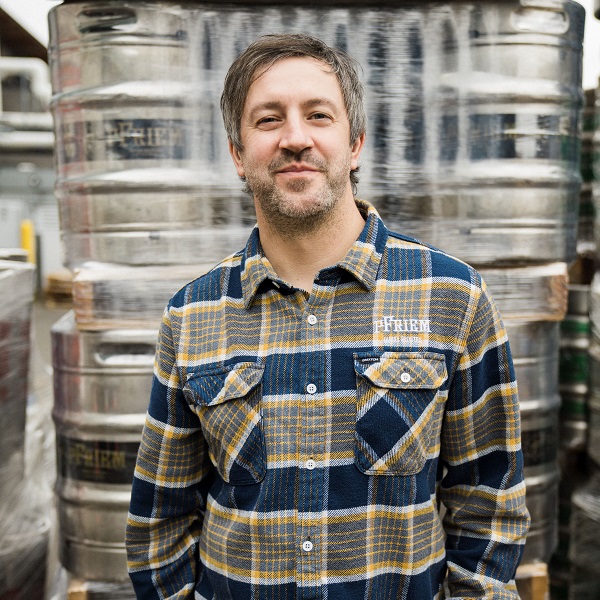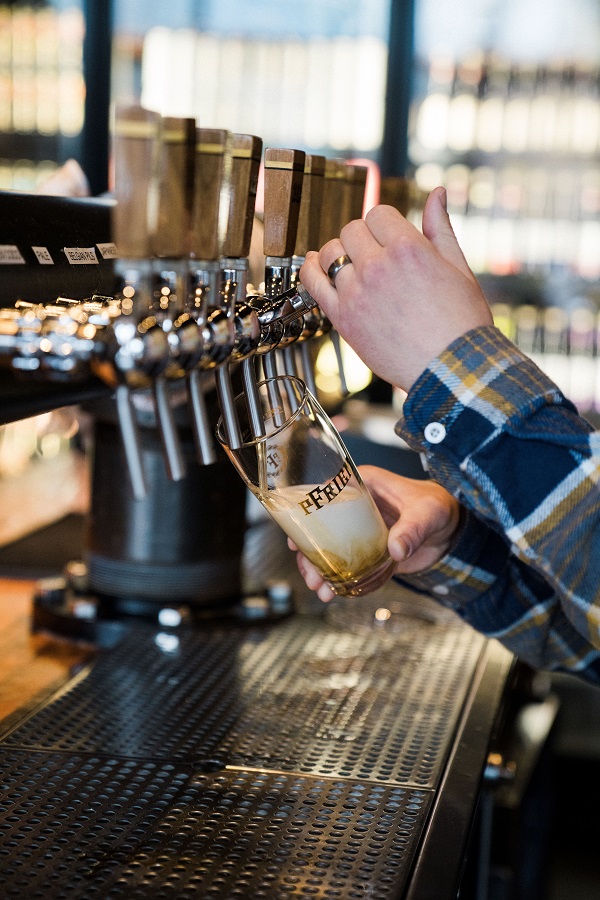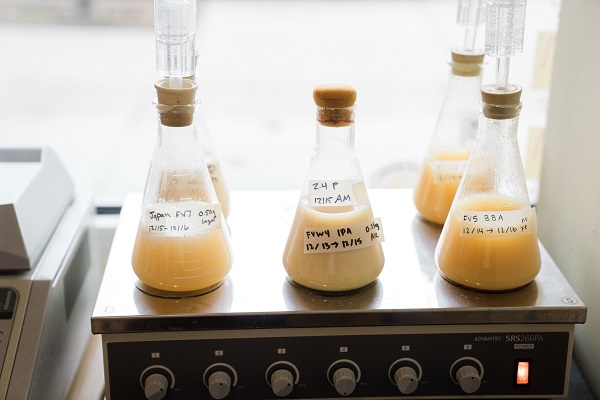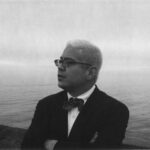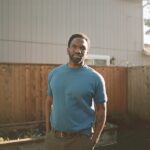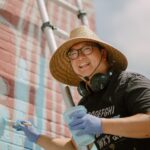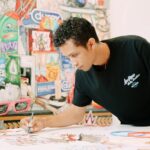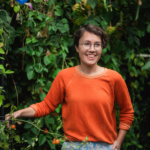The Toolkit
Written by Gabriel Urza; Photographed by Laura Dart
It’s been raining for a week when I meet Josh Pfriem, brewmaster and co-founder of pFriem Beer, at his tasting room fronting the Columbia in Hood River. In a town of 12,000 people with a ridiculous brewery-to-resident ratio, pFriem is the cool kid on the block. It’s the place to take visitors for dinner or to grab a beer after a day of work, or a bike ride, or any of the wind sports available outside the brewery’s front door.
We start to talk beer, but eventually the conversation steers towards something broader—about what it means to be a craft beer now, in a time where seemingly everything is a craft. Josh Pfriem has theories about this. Craft implies process. It involves risk and experimentation. It’s about an aesthetic, not an algorithm.
I don’t know anything about brewing beer, will drink anything in the fridge. But the process, the creative challenges and moments of change—these are relatable, universal. As we talk, I come to understand that the decisions that went into the glass in my hand are a lot like the decisions behind drafting a novel or sketching a painting or choreographing a dance.
Jumping Off
Every artist has an origin story. Most often, it’s a love story.
“Before I fell in love with brewing I fell in love with beer,” Josh tells me. I’m sipping copper-colored draft, and I catch his eyes occasionally landing on my glass, admiring his work.
It seems like it’s a story he’s used to telling: beers at Boundary Bay, the local microbrew in Bellingham, back in his snowboard bumming days at Western Washington University, where he’d meet friends after a day on the mountain. The home brew kit he bought when he was twenty-one. But what he seems to be recalling, what seems to spark something larger, isn’t just the beer. It’s that sense of being in a specific place at a specific time.
“I love après,” Josh says. Après anything—après snowboard or kayak, or mountain biking. He believes in “place and connection,” the way you get to know someone after a couple beers that’s different than other forms of connection. I know what he means. The excitement of a first creative community, the feeling that the work is tied to place and people. The beauty of a familiar setting, where the unexpected can occur.
Constraints
Josh is now in a place where he has seemingly every creative option a brewer could hope for at hand. I find pFriem six-packs wherever I go these days, and Josh has won gold medals at the World Beer Cup and the Great American Beer Festival. The brewery sells over 75 different types of beer: Abrikoos and American Lager, Bosbessen and Bourbon Barrel Aged Barleywine, Saison and Schwarzbier. But when I ask where his initial sense of taste came from, it’s the lack of options that he cites.
Twenty years ago, starting a craft brewery meant going against a brewing establishment that dominated sales, but also flattened taste and dictated what people thought they should like. The ideal beer product was something that offended no one, and the ideal beer drinker was someone without their own distinct wants. The great barstool debate wasn’t about a Hazy IPA versus a Farmhouse Ale, but about Coors versus Budweiser.
Continue Reading
“It was a fuck you to the man,” Josh says about early craft brewing. “But also, we could do this better.”
Josh tells me about his first commercial brewing experience in Utah, back when state liquor laws limited beer to a maximum of 4% alcohol by volume. Utah might seem like an odd place for a brewer to get his start, but there is often something to be learned by constraints.
“Beer is so fragile at four percent,” Josh says, almost wistfully. “You can’t hide behind anything.” It forced him to choose carefully, to hone a recipe to perfection.
Constraints yield innovation. When we take an option away, another appears out of necessity. Josh offers the example of Japanese lagers, how the substitution of rice for barley changed the nature of the beer. “Behind all of these different styles of beer—whether it’s a type of pilsner or a Flanders red, or the origin of IPA, there’s this rich history that ties into humanity and culture and place.”
Influence
When I ask about influence, Josh mentions a three-week bike trip that he took with his wife in Belgium. “It wasn’t just the beer that was better. It was the food, the community. There was a lot for Americans to glean.”
He gleans not only from travel, but from his sense of place here in the Columbia River Gorge. The raw ingredients for beer, traditionally, are hops, malt, yeast. But these basics are always changing. “Nowadays there could be lactose, there could be spices, there could be fruit.” Josh leans on the resources available to him by sourcing cherries from Mosier and peaches from Maryhill for pFriem’s Lambic-inspired beers.
Josh is telling me about an early job at a fine dining restaurant in Utah, describing the restaurant’s wine collection, when suddenly his eyes light up. He’s a casual guy by nature, flannel and jeans, but now his vocabulary raises a register.
“They were getting all these great Pinot Noirs out of Oregon. I remember trying those Pinot Noirs, and those soft subtle notes, with all those layers of complexity. So huge, but so small and so graceful. So intriguing on the palette.” Suddenly there’s a specificity to his descriptions, a sense of texture and detail. “This is how I wanted to make beer.”
Resisting Habits
“I’ve been doing this for almost twenty years,” Josh says. “You fall into patterns.”
It’s something that happens to all of us, at some point. We know ourselves too well. We begin to miss the sense of surprise, the productive messiness that comes with the early work.
So how to outmaneuver these habits of mind? As with most art practices, brewing benefits from careful editing. For Pfriem, this means an entire team enlisted to give blind feedback on new recipes, whose reactions are carefully recorded in logbooks. And “feedback” here doesn’t mean a simple “like/don’t like.” It usually takes new managers six months to a year to learn the vocabulary necessary to fully take part in the revising process, and the meetings can be very critical.
Josh also cites collaboration as a way to get beyond his comfort zone, to challenge complacency. “I’m very process-oriented, but a lot of my friends come from a very different angle,” Josh says. He seeks out brewers that might work more chaotically, or spontaneously, or create a new sense of possibility. A recent collaboration with the Portland brewery Great Notion resulted in a new lager that the breweries titled, fittingly, “Twins.”
“It’s not always comfortable,” Josh says about collaboration, about stretching boundaries and ceding control. “But you might learn something in the process.”
The rain is still coming down when I leave pFriem an hour later. Across the street, the gray mass of the Columbia slides past. The warm lightheadedness of an afternoon buzz settles in, and I find myself thinking about Josh’s words about place and people—about how a conversation over a beer can create connections and shake us into a new sense of what’s possible.

